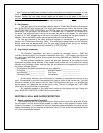
Next, find the vent safety shut-off switch inside the draft hood on the back of the stove. It is the
small disc-shaped object screwed to an L-shaped bracket; there are two (2) sets of holes on this
bracket.
Position the vent safety shut-off switch so the switch is as far down in the flue as
possible, or in a position closest to the floor. This is accomplished when the upper set of holes on
the bracket is aligned with the two holes in the back of the stove.
D. Gas Pressure
The input rate of this vented gas fireplace heater is 33,200 BTU/HR with liquid propane
and 32,000 BTU/HR with natural gas. The supply gas pressures are listed in the manual under
the LISTING AND CODE APPROVALS and outlined under the “Performance Summary Table”
listed earlier. The gas supply line should be ½” in diameter with ½” male NPT for connection to
the stove. This connection point is found on the lower rear portion of the heater. It is also helpful
to install a 1/8” NPT plugged tap at the inlet to the stove for checking the inlet gas pressure. In
addition, it would be useful to add a manual gas shutoff at the inlet to the stove.
The inlet gas pressure to the stove should be adjusted in accordance with the guidelines
stated in the “Performance Summary Table.” The vented gas fireplace heater and its individual
shutoff valve must be disconnected from the gas supply piping system during any pressure
testing of that system at test pressures in excess of ½ PSIG (3.5 kPa).
E. High Altitude Installation
For Canadian installations, this stove is certified for elevations from 0 – 2000 feet
(0-610m) above sea level. For Canadian installations above 610 – 1370 meters, the orifice size
for natural gas is #35 DMS, and for liquid propane the size is #52 DMS per CAN/CGA 2.17 tests,
“current edition.”
For high altitude installations, consult the local gas distributor or the authority having
jurisdiction for proper rating methods. If the installer must convert the unit to adjust for varying
altitudes, the information sticker must be filled out and adhered to the appliance at the time of
conversion. (Sample Sticker:)
→This appliance has been converted for use at an altitude of _____________________
Orifice size ___________________ Manifold Pressure ___________________
Input (Btu/HR) __________________ Fuel Type ___________________
Conversion Date ________________ Converted by ___________________
At the higher altitudes, gas codes make it necessary to decrease the amount of gas
input. This decrease in gas flow is accomplished by using an orifice of the correct size. The input
should be reduced by four percent (4%) for each 1000 feet above sea level — a qualified gas
service person can determine the correct burner orifice. The unit is shipped with a #51 DMS
orifice for LP and a #33 orifice for natural gas.
All installation aspects of this stove must conform to the national fuel gas “listing and
code” ANSI Z223.1/NFPA 54 or CAN1-B149 “current edition.”
SECTION III: WALL AND FLOOR PROTECTION
A. Heater Location and Wall Protection
This freestanding stove is a high efficiency unit, which means it gives off a great deal of heat.
For this reason, the unit should not be located in a traffic area or near drapes or curtains, which
present a fire hazard. It is important to allow for adequate clearance between the stove and the
nearest combustible; the unit must be at least three inches (3”) from a rear wall and twelve inches
(12”) from a combustible sidewall.


















